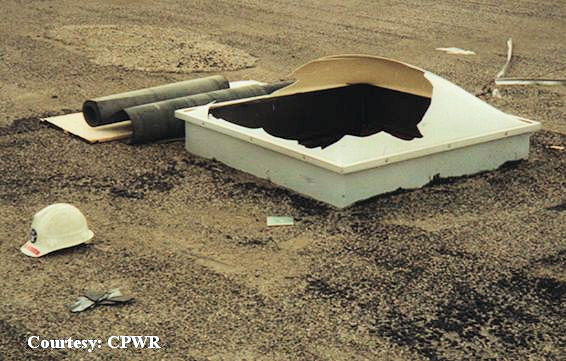Holes
OSHA defines a floor hole as a gap or open space in a floor, roof, horizontal walking-working surface, or similar surface that is at least 2 inches (5 cm) in its least dimension.
Four feet or above. OSHA 1910.28(b)(3)(i) states each employee must be protected from falling through any hole (including skylights) that is 4 feet (1.2 m) or more above a lower level by:
- secured covers;
- guardrail systems;
- travel restraint systems; or
- personal fall arrest systems.
Below four feet. OSHA 1910.28(b)(3)(ii) states each employee must be protected from tripping into or stepping into or through any hole that is less than 4 feet (1.2 m) above a lower level by:
- secured covers; or
- guardrail systems.
- Roof drains
- Concrete penetrations for piping and ducts
- Skylights
- Unfinished stairways or missing steps
- Pier drilled holes
- Excavations
- Chute floors
- Drains
- Mechanic pits
- Holes created during construction
- Rotting floors that could give way
- Working platforms for silos, tanks, etc.
Stairway Floor Holes
Each employee must be protected from falling into a stairway floor hole by a fixed guardrail system on all exposed sides, except at the stairway entrance. However, for any stairway used less than once per day where traffic across the stairway floor hole prevents the use of a fixed guardrail system, the employer may protect employees from falling into the hole by using a hinged floor hole cover that meets the criteria in OSHA Standard 1910.29, and a removable guardrail system on all exposed sides, except at the entrance to the stairway.
Ladderway Holes
Each employee must be protected from falling into a ladderway floor hole or ladderway platform hole by a guardrail system and toeboards erected on all exposed sides, except at the entrance to the hole, where a self-closing gate or an offset must be used.
Hatchway and Chutefloor Holes
Each employee is protected from falling through a hatchway and chutefloor hole by:
- A hinged floor-hole cover and a fixed guardrail system that leaves only one exposed side. When the hole is not in use, the employer must ensure the cover is closed or a removable guardrail system is provided on the exposed sides;
- A removable guardrail system and toeboards on not more than two sides of the hole and a fixed guardrail system on all other exposed sides. The employer must ensure the removable guardrail system is kept in place when the hole is not in use; or
- A guardrail system or a travel restraint system when a work operation necessitates passing material through a hatchway or chute floor hole.
Knowledge Check Choose the best answer for the question.
2-2. What protective measure would be suitable to protect an employee from falling through a hole that is more than 4 feet (1.2 m) above a lower level?
You forgot to answer the question!

